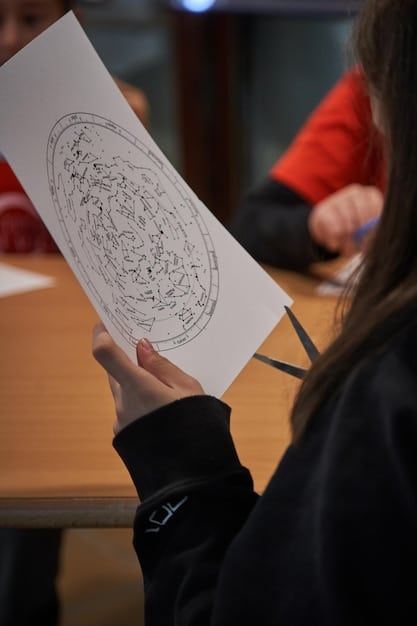Boost Inner Peace by 15% in 2025: Daily Gratitude Practices

Daily gratitude practices can increase inner peace by 15% in 2025 by shifting focus to positive aspects of life, fostering resilience, improving relationships, enhancing physical health, and boosting overall happiness through simple, consistent actions.
Feeling overwhelmed by the daily grind? Discover how can daily gratitude practices increase your inner peace by 15% in 2025, fostering a sense of calm and contentment amidst life’s challenges. It’s about more than just saying ‘thank you’; it’s a transformative approach to living.
The Science-Backed Power of Gratitude
Gratitude isn’t just a warm, fuzzy feeling; it’s a practice deeply rooted in psychological and neurological research. Understanding the science behind gratitude can provide a strong foundation for integrating it into your daily life.
The Neurological Impact of Gratitude
Studies have shown that expressing gratitude activates specific areas of the brain associated with reward, positive emotion, and social bonding. This neurological response can contribute to a greater sense of well-being.
Gratitude and Mental Health
Research indicates that consistent gratitude practices can reduce symptoms of depression and anxiety. By shifting focus away from negative thoughts and towards positive aspects of life, gratitude can promote a more balanced emotional state.

Here are some key benefits of practicing gratitude, backed by scientific research:
- Reduced stress and anxiety
- Improved mood and overall happiness
- Stronger immune system
- Better sleep quality
Incorporating gratitude into your daily routine can be surprisingly simple, yet profoundly impactful on your mental and emotional well-being.
Setting Realistic Gratitude Goals for 2025
Embarking on a gratitude journey requires setting achievable goals that align with your lifestyle. Starting small and gradually increasing your efforts ensures sustainability and maximizes the positive effects.
Defining Your “15% Increase”
Before diving in, consider what a 15% increase in inner peace looks like for you. Is it feeling less stressed, more content, or more connected to others? Setting a clear benchmark will help you track your progress.
Small Steps, Big Impact
Begin with simple gratitude exercises, such as writing down three things you’re grateful for each day. These small actions can quickly accumulate and lead to significant improvements in your overall well-being.
Here are some practical tips for setting realistic gratitude goals:
- Start with a manageable timeframe (e.g., one week).
- Focus on specific areas of your life (e.g., relationships, health).
- Track your progress using a journal or app.
- Adjust your goals as needed to stay motivated and engaged.
Remember, the key is consistency. Even small, regular gratitude practices can create a ripple effect of positivity in your life.
Simple Daily Gratitude Practices to Implement
Integrating gratitude into your daily life doesn’t require grand gestures; it’s about finding small moments to appreciate the good things around you. These simple practices can easily fit into any routine.
The Gratitude Journal
One of the most effective ways to cultivate gratitude is through journaling. Dedicate a few minutes each day to write down things you’re thankful for, whether big or small.
Gratitude Meditation
Take time to meditate on the things you appreciate in your life. Visualize positive experiences and focus on the feelings of joy and contentment they evoke.

Here are some additional gratitude practices to try:
- Express gratitude to others through thank-you notes or verbal appreciation.
- Savor positive experiences by fully engaging with your senses.
- Reframe negative thoughts by focusing on the lessons learned or silver linings.
By incorporating these practices into your daily life, you can create a habit of gratitude that enriches your overall well-being.
Overcoming Obstacles to Consistent Gratitude
Maintaining a consistent gratitude practice isn’t always easy; life’s challenges can sometimes make it difficult to focus on the positive. However, with the right strategies, you can overcome these obstacles and stay on track.
Dealing with Negative Emotions
Acknowledge and validate your negative emotions, but don’t let them overshadow your gratitude practice. Use gratitude as a tool to balance out your perspective and find moments of light even in difficult times.
Combating Cynicism
Cynicism can be a major obstacle to gratitude. Challenge cynical thoughts by actively seeking out evidence of goodness and positivity in the world around you.
Here are some strategies for overcoming obstacles to consistent gratitude:
- Set reminders to engage in gratitude practices throughout the day.
- Find a gratitude buddy to support and motivate you.
- Forgive yourself for missed days and simply start again.
Remember, gratitude is a muscle that strengthens with practice. Don’t give up if you encounter setbacks; keep practicing, and you’ll gradually build resilience and a more grateful outlook.
Measuring Your Progress: Tracking Inner Peace Gains
To determine whether your daily gratitude practices are increasing your inner peace, it’s essential to track your progress. This allows you to see tangible results and stay motivated on your journey.
Self-Assessment Tools
Use self-assessment questionnaires or journal prompts to evaluate your levels of stress, anxiety, and overall happiness. Track these metrics over time to identify trends and patterns.
Qualitative Observations
Pay attention to how you feel on a daily basis. Are you experiencing more moments of joy, contentment, or connection? Note these observations in your gratitude journal or a separate notebook.
Here are some ways to measure your progress:
- Use a scale of 1 to 10 to rate your daily stress levels.
- Track the number of positive interactions you have with others each day.
- Monitor your sleep quality and overall energy levels.
By tracking your progress, you can gain valuable insights into the effectiveness of your gratitude practices and make adjustments as needed to optimize your results.
Sustaining Gratitude as a Long-Term Lifestyle
The ultimate goal is to integrate gratitude into your daily life as a sustainable, long-term practice. This requires ongoing commitment and a willingness to embrace gratitude as a way of life.
Make Gratitude a Habit
Incorporate gratitude practices into your existing routines, such as pairing gratitude journaling with your morning coffee or expressing gratitude before bed each night.
Cultivate a Grateful Mindset
Seek out opportunities to appreciate the good things in your life, even during challenging times. This can involve reframing negative thoughts, focusing on small joys, and expressing gratitude to others.
Here are some tips for sustaining gratitude as a long-term lifestyle:
- Join a gratitude community or online forum for support and inspiration.
- Attend gratitude workshops or retreats to deepen your understanding.
- Read books or articles about gratitude to stay informed and motivated.
By making gratitude a central part of your life, you can experience lasting benefits for your mental, emotional, and physical well-being.
| Key Aspect | Brief Description |
|---|---|
| 😊 Daily Journaling | Write three things you’re grateful for each day. |
| 🧘 Gratitude Meditation | Meditate on the positive aspects of your life. |
| 🙏 Express Thanks | Verbally thank people or write thank-you notes. |
| 💖 Positive Reframing | Reframe negative thoughts to find the silver lining. |
Frequently Asked Questions
▼
Gratitude activates areas of the brain associated with reward, positive emotion, and social connection, fostering a sense of well-being and reducing negative feelings.
▼
Yes, studies show that gratitude can significantly reduce stress levels by shifting focus from worries to positive aspects of life, promoting a calmer mental state.
▼
Daily gratitude practices are ideal for consistent benefits. Even a few minutes each day can lead to substantial improvements in your overall well-being over time.
▼
Start by focusing on small things, like a warm cup of coffee or a sunny day. Acknowledge difficult emotions but try to identify at least one positive aspect to appreciate.
▼
When used in a balanced way, gratitude generally has no major downsides. However, it’s also important to address problems and challenges instead of only focusing on the positive..
Conclusion
Incorporating daily gratitude practices is a powerful way to enhance your inner peace and overall well-being, setting the stage for a more fulfilling 2025. By consistently focusing on the positive aspects of your life, you can cultivate a sense of calm, joy, and connection that enriches your daily experiences.





